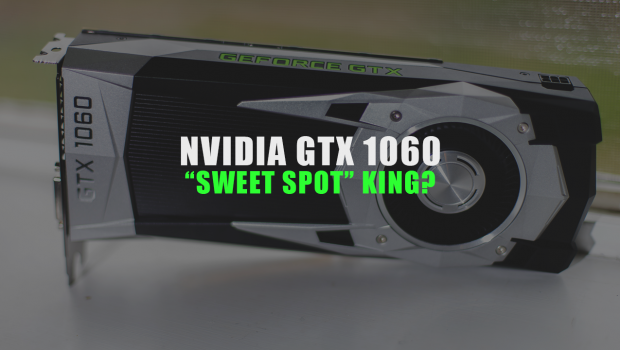Review – Nvidia GTX 1060
The Nvidia GTX 1060. With the Founder’s Edition card coming in at $299 a pop, is this the new “sweet spot” king? Time to find out.
It has been quite the year for Nvidia and AMD, the pressure to make the best VR-ready GPU money can buy has been intense. Recently, AMD has been boasting about the RX 480, a graphics card capable of running VR games that many enthusiasts could potentially afford. Nvidia naturally had to come up with something in response – and so they gave us the GTX 1060.
Before we get into crunchin’ numbers, let’s take a look at the card itself. Unlike the 960 reference cards, Nvidia decided to keep the design scheme going with the GTX 1060 Founder’s Edition and it looks like it legitimately belongs with the rest of the FE family. The shroud has more matte black then its bigger brothers but still has the space gray finish on the rest of the card. The PCB is completely black and short, but the card itself is a conventional standard full-length we’d expect to see from more serious cards due to its blower design. Being its a shorter PCB, its actually quite light in comparison to many other cards. On the top you’ll notice the card only takes a 6-pin power cable (toward the end of the whole card, not the end of the PCB – thumbs up there), has the green glowing “GEFORCE GTX” – but is missing a place to connect an SLI bridge. On the side, you have one DVI port, three display ports, and an HDMI port.
The GTX 1060 is rocking Nvidia’s new Pascal architecture. The card comes clocked at 1506MHz with a Boost Clock capable of at least 1708MHz (Mine, for instance, was boosting up to 1911MHz without touching any software). Compared to its older brother (the GTX 960), it has more CUDA cores, a smaller die, and has a higher clocks for the GPU and memory. You can see for yourself that in nearly every manner, the GTX 1060 is technically a solid upgrade on paper:
| GTX 960 | GTX 1060 | |
| SMs | 8 | 10 |
| CUDA Cores | 1024 | 1280 |
| Base Clock | 1126 | 1506 MHz |
| GPU Boost Clock | 1178 | 1708 MHz |
| Texture Units | 64 | 80 |
| Texel Fill-rate | 72 Gigatexels/sec | 120.5 Gigatexels/sec |
| Memory Clock (Data Rate) | 7,000 MHz | 8,000 MHz |
| Memory Bandwidth | 112 GB/sec | 192 GB/sec |
| ROPs | 32 | 48 |
| L2 Cache Size | 1024 KB | 1536 KB |
| TDP | 120 Watts | 120 Watts |
| Transistors | 2.94 billion | 4.4 billion |
| Die Size | 227 mm^2 | 200 mm^2 |
| Manufacturing Process | 28mm | 16mm |
Nvidia hooked me up with the GTX 1060 about a week or so ago, so I thought I’d give the card a good run for its money while being forced to sit down and play some games. Where better would you test a new graphics card other then a LAN party? Previously, I had been running an AMD R9 290X in my main rig so I was skeptical to find out how well the 1060 would match up. I swapped out the cards and off I went to PDXLAN.
When I finally sat down and launched my first game, I experienced what could only be described as euphoria. I couldn’t believe it. Launching Fallout 4 with max settings and having no lag right off the bat blew my expectations away. In the back of my head I had a sneaking suspicion that the card would have caught up to my 290X but I let my AMD fanboy-ism cloud my judgement. It had been a while since I upgraded cards and to see the annihilation of some ghouls with no noticeable frame-rate drops almost made me start a new campaign. I had been so used to getting sub-60 FPS with my previous card that I had forgotten what it was like to have a new graphics card.
Let me make it perfectly clear though, this card is nearly the perfect solution for ultra settings on 1080p game play. For the majority of my games, I was able to achieve atleast 60 frames per second.
Nvidia claims that, “Thanks to the efficiency of NVIDIA’s Pascal architecture, the GeForce GTX 1060 brings the performance of our previous flagship GeForce GTX 980 to every gamer, yet it consumes only 120 watts,” so I wanted to put that to the test.
I’m working with my main rig, primarily used for gaming and light video/photo editing.
| OS | Windows 10 Professional |
| CPU | Intel i7-4770k @3.9GHz |
| Motherboard | ASRock Z87M Extreme4 |
| RAM | 32GB Kingston DDR3 @ 1600MHz |
| Harddrive/SSD | SanDisk Ultra II 960GB SSD |
I did two runs of everything with the 1060. One run clocked at the advertised boost clock, and another at what I was able to achieve. I was actually able to get a stable GPU clock of 2050MHz and a memory clock of 4779MHz without touching the voltage. I utilized EVGA Precision OC X for my overclocking.
For my first test, I ran UNIGINE’s Heaven benchmark (basic edition):
| API | DirectX 11 |
| Quality | Ultra |
| Tessellation | Extreme |
| Stereo 3D | Disabled |
| Multi-monitor | Disabled |
| Anti-aliasing | x8 |
| Full Screen | Checked |
| Resolution | 1920×1080 |
- GTX 1060 (stock): 59.9FPS
- GTX 1060 (OC): 71.2FPS
- GTX 980: 69.6FPS
- GTX 960: 33FPS
- R9 290X: 57.3FPS
I then tried 3DMark’s standard Firestrike test, the following are the graphics (not combined) results:
- GTX 1060 (stock): Score of 12340, averaging 58.31 on test one, 49.68 on test two
- GTX 1060 (OC): Score of 14466, averaging 68.35FPS on test one, 58.25FPS on test two
- GTX 980: Score of 14325, averaging 69.11FPS on test one, 56.96FPS on test two
- GTX 960: Score of 7656, averaging 36.76FPS on test one, 30.41FPS on test two
- R9 290X: Score of 12876, averaging 61.42FPS on test one, 51.53 on test two
3DMark’s Time Spy is the only DX12 benchmark I was able to test. The following results are from the graphics (not combined) tests:
- 3GTX 1060 (stock): Score of 3790, averaging 25.13FPS on test one, 21.41FPS on test two
- GTX 1060 (OC): Score of 4413, averaging 29.43FPS on test one, 24.81FPS on test two
- GTX 980: Score of 4298, averaging 28.41FPS on test one, 24.35 on test two
- GTX 960: Score of 2229, averaging 14.66 on test one, 12.68 on test two
- R9 290X: Score of 4083, averaging 27.64FPS on test one, 22.67 on test two
GTA V was an instant classic for many, especially with Rockstar’s continued support for online play. Below are the settings I changed the game to before running the in-game benchmark:
| Screen Type | Fullscreen |
| Resolution | 1920×1080 |
| FXAA | On |
| MSAA | X8 |
| NVIDIA TXAA | Off |
| VSync | Off |
| Population Density | Max |
| Population Variety | Max |
| Distance Scaling | Max |
| Texture Quality | Very High |
| Shader Quality | Very High |
| Shadow Quality | Very High |
| Reflection Quality | Ultra |
| Reflection MSAA | X8 |
| Water Quality | Very High |
| Particles Quality | Very High |
| Grass Quality | Ultra |
| Soft Shadows | Softest |
| Post FX | Ultra |
| Motion Blur Strength | None |
| In-Game Depth of Field Effects | On |
| Anisotropic Filtering | X16 |
| Ambient Occlusion | High |
| Tessellation | Very High |
| Long Shadows | On |
| High Resolution Shadows | On |
| High Detail Streaming While Flying | On |
| Extended Distance Scaling | Max |
| Extended Shadows Distance | Max |
| Frame Scaling Mode | Off |
- GTX 1060 (stock): 38.1FPS
- GTX 1060 (OC): 44.59FPS
- GTX 980: 40.78FPS
- GTX 960: 21.4FPS
- R9 290X: 32.79FPS
Thought I’d try a strongly supported AMD title, so I went with Tomb Raider benchmark:
| Fullscreen | Checked |
| Exclusive Fullscreen | Checked |
| Resolution | 1920×1080 |
| V-Sync | Off |
| Texture Quality | Ultra |
| Texture Filter | Anisotropic 16x |
| Anti-Aliasing | 4x SXSAA |
| Shadows | Ultra |
| Shadow Resolution | High |
| Level of Detail | Ultra |
| Post Processing | Checked |
| High Precision | Checked |
| Tessellation | Checked |
| Hair Quality | Normal |
| Reflections | High |
| Depth of Field | Ultra |
| SSAO | Ultra |
- GTX 1060 (stock): 61.07FPS
- GTX 1060 (OC): 73.7FPS
- GTX 980: 73.4FPS
- GTX 960: 37.7FPS
- R9 290X: 67FPS
Another “AMD ready” title, Hitman:
| Resolution | 1920×1080 |
| Fullscreen | Check |
| Refresh rate | 60 |
| Vsync | NOT checked |
| MSAA | 8x |
| Exclusive Fullscreen | Checked |
| Shadow Quality | Ultra |
| Texture Quality | High |
| FTexture Filter | Anisotropic 16x |
| Reflections | High |
| FXAA | Checked |
| Global Illumination | Checked |
| Tessellation | Checked |
| Level of Detail | Ultra |
| Depth of Field | High |
| SSAO | High |
| Bloom | Normal |
- GTX 1060 (stock): 38.1FPS
- GTX 1060 (OC): 44.59FPS
- GTX 980: 58.99FPS
- GTX 960: 29.42FPS
- R9 290X: 56.5FPS
This was a suggested game to test in Nvidia’s reviewer guide, Metro: Last Light.
| DirectX | 11 |
| Resolution | 1920×1080 |
| Quality | Very High |
| Texture filtering | AF 16X |
| Motion Blur | Normal |
| SSAA | Checked |
| DX11 Tesselation | Verry High |
| NVidia PhysX | Unchecked |
| Scene | D6 |
| Runs | 5 |
- GTX 1060 (stock): 52.6FPS
- GTX 1060 (OC): 60.6FPS
- GTX 980: 62.8FPS
- GTX 960: 32.8FPS
- R9 290X: 49FPS
Battlefield 4 is a classic in the series, and I couldn’t help but test it. I feel like it has a little bit of everything, with its dynamic explosions, vehicles, vast environments and more. I played on the Ultra preset.
Testing methodology: Spawned in to testing range, let the game sit for a minute. Spawn at main point. Run left along side the coast, through the water and foilage. When you reach it, do not cross the bridge. Run to the helicopter, fly the helicopter to the boats. Parachute down to the boats. Drive the boat like a bat out of hell to the range. Shoot the first three barrels you see, let the third one kill you.
- GTX 1060 (stock): 128.27FPS
- GTX 1060 (OC): 149.81FPS
- GTX 980: 141.819FPS
- GTX 960: 72.97FPS
- R9 290X: 103.25FPS
Overall, I’m impressed. As you can tell, the GTX 1060 slays in some of these titles. It is worth noting that Tomb Raider and Hitman were “AMD Ready” titles originally, as Metro was a popular Nvidia title – so please take that into consideration when looking at these results. Overall, frame rates were noticeably stable and I could hardly tell the fans were picking up. Even turned up manually, the sound of the card didn’t sound obtrusive. As you can see, it does pack the punch of a GTX 980 while being as efficient as a GTX 960. Impressive.
Nvidia has informed us that the Founder’s Edition card will only be available directly through Nvidia and will be sold for $299. Founder Edition cards for the GTX 1060 will NOT be sold by other partners. Do not fret though, as you may find the following cards on Newegg or Amazon starting today:
- ASUS STRIX-GTX1060-6G-GAMING: $329
- ASUS Turbo Edition: $249
- EVGA GTX 1060 edition: $249
- EVGA GTX 1060 Superclocked (SC) Edition: $259
- Gigabyte GV-N1060G1 GAMING-6GD: $289
- MSI GeForce GTX 1060 GAMING X 6G: $289
- MSI GeForce GTX 1060 Gaming 6G: $279
- MSI GeForce GTX 1060 Armor 6G OC: $259
- MSI GeForce GTX 1060 6GT: $249
- PNY GeForce GTX 1060: $259
- Zotac GeForce GTX 1060 AMP 6GB: $279
- Zotac ZT-P10600A-10L ZOTAC GTX 1060 Mini 6G: $249
If you’re looking to get started, or haven’t upgraded in a while, I think the GTX 1060 is a right card for many people on a tighter budget. For under $300, this is pretty hard to beat. If you’re looking at this or the AMD RX 480, I suggest checking out Paul’s video to see how it paired up. In any way, for 1080p gaming this card is going to eat whatever you throw at it with mostly high, some medium settings. More serious enthusiasts should probably look into getting the GTX 1070 – especially considering that you cannot SLI the GTX 1060.
Special thanks to my friends from Nvidia, Jacob from EVGA, and my buddy Charles. Without them, this review wouldn’t have been possible.
What do you think? Been on the fence for getting a new graphics card? I miss anything? Let me know in the comments below!










One Response to Review – Nvidia GTX 1060